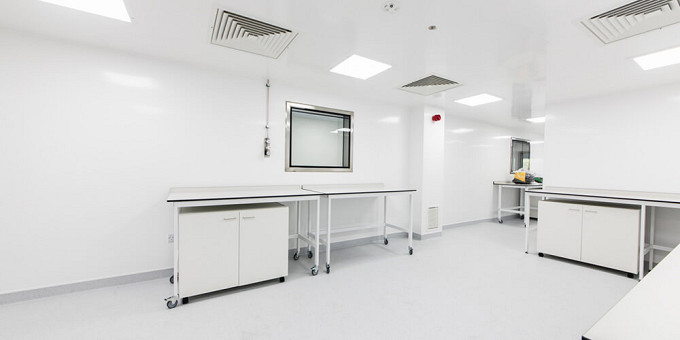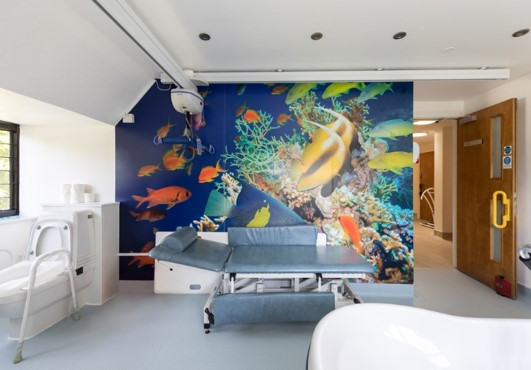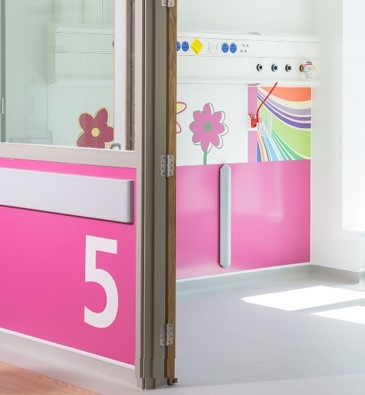Impact-resistant wall surfaces
Uses of Impact-Resistant Wall Panels
Impact-resistant wall panels are used to protect wall structures from impacts and abrasions, as well as to make spaces safer for users. These panels are resistant to chemicals, which makes surface cleaning and washing easier. The minimal number of seams makes the space more hygienic and facilitates the installation of equipment, as the equipment can be placed freely without being limited by grout lines.
Common uses for protecting against impacts include kick protection, corridor and door protection, patient room bed areas, and other spaces where beds or other large wheeled objects are moved, posing a risk of damaging walls and doors. In addition to wall panels, the selection also includes corner protectors, wall protection lists, and handrails.
Hygiene is improved with wall panels, particularly as wall material in bathrooms, laboratories, and equipment cleaning areas. The antimicrobial feature is especially important in spaces where cleaning bodily fluids is an ongoing challenge. Due to their excellent cleanability, wall panels are also a popular material in the food industry and restaurant spaces.
Impact-resistant wall panels improve safety and the durability of structures in spaces where users may act aggressively. An impact-resistant wall panel is also an excellent option for public spaces.
What is an Impact-Resistant Wall Panel?
An impact-resistant wall panel is a thin (1.0 – 2.0 mm) surface material used to create nearly seamless, hygienic, and impact-resistant wall surfaces. Wall panels come in a wide range of colors, and custom prints can also be implemented. The surface of the wall panels can be glossy or lightly embossed with a matte finish.
Korpinen offers solutions for various applications with either the PVC-based antimicrobial BioClad brand or the higher fire rating (B s1 d0) Acrovyn brand.
The panels are available in various size options ranging from 1200-1300 x 2500-3000 mm.
Considerations for Different Applications
The thickness of the panel should be selected based on the intended use of the space and the wall structure:
- 1 mm (Acrovyn) - low impact resistance in a standard panel wall, high impact resistance in strong wall structures (block or concrete).
- 1.5 mm (Acrovyn) – medium impact resistance in a standard panel wall, high impact resistance in a double-layered wall (special hard or moisture-resistant plasterboard or plywood).
- 2.0 mm (BioClad) – high impact resistance for all wall structures.
The Acrovyn panel is the right choice when a higher B s1 d0 fire rating is required. The BioClad panel is antimicrobial, more cost-effective, and offers higher impact resistance for applications where the B s3 d0 fire rating is sufficient. Fire rating requirements do not apply to small building components.
Impact-resistant wall panels do not have a water barrier certification according to the ETAG 022 standard, so in wet areas, they should be installed over an approved waterproofing layer, as with traditional surface materials.
Installation
Before gluing, ensure that the surfaces are dry. Clean the back of the cut panel (the side without the green protective film) and the wall of dust and dirt, ensuring a 2 mm gap around the edges of the panel. Attach a 25 mm wide double-sided tape suitable for PVC adhesion at the seam points of the panels on the wall. The double-sided tape will help keep the panel in place while the PU adhesive dries. Mix the A and B components of the PU adhesive in a bucket. Use a drill or mixing machine at a low speed with a mixing paddle. The working time of the adhesive is 40 minutes. Apply the adhesive evenly to the back of the panel with a notched trowel (4 mm notch size). The adhesive should extend about 13 mm from the edge of the BioClad panel (considering the double-sided tape at the seam). Remove the protective film from the double-sided tape and press the BioClad panel into place, adhering it to the tape. Press the panel firmly against the wall using a rubber roller or mallet. Allow the adhesive to dry for 8–12 hours depending on the conditions. Finish the edges and seams with (antibacterial) silicone or by welding the plastic. Remove the protective film from the panel surface only just before the space is ready for use.
Assistance with Design
We are happy to assist in selecting the right material and planning the project. Sample pieces are available!
For more information
Anu Pennanen
Business Development Manager | Support for Builders and Designers
+358 40 527 0742 anu.pennanen@korpinen.com
Request a quote from our experts here.
Read more about the product here.
Presentation on safety products >





